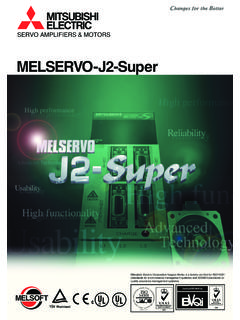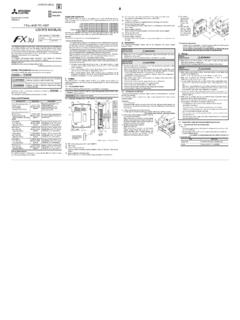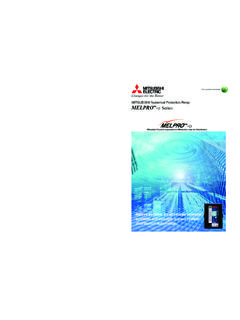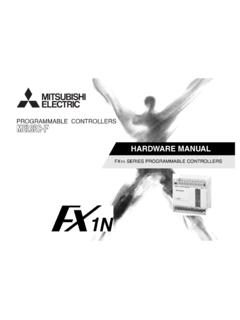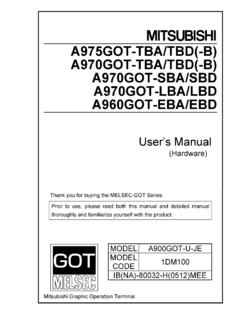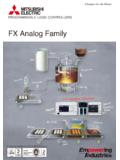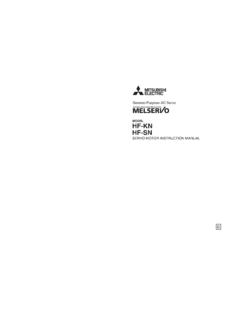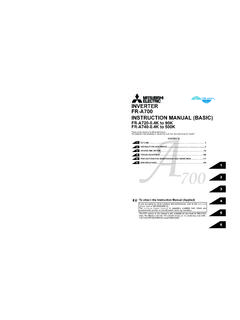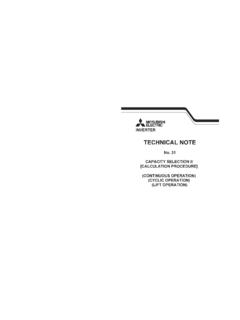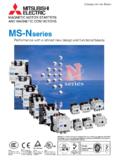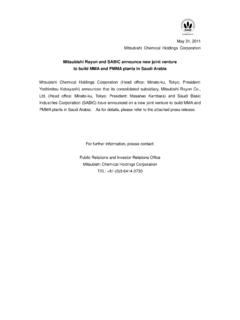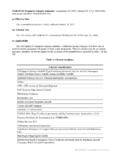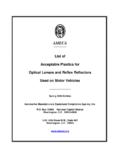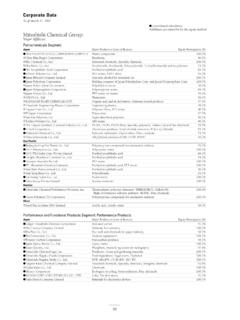Transcription of MELDAS is a registered trademark of Mitsubishi …
1 MELDAS is a registered trademark of Mitsubishi Electric Corporation. Other company and product names that appear in this manual are trademarks or registered trademarks of their respective companies. i Introduction Thank you for selecting the Mitsubishi numerical control unit. This instruction manual describes the handling and caution points for using this AC servo/spindle. Incorrect handling may lead to unforeseen accidents, so always read this instruction manual thoroughly to ensure correct usage. Make sure that this instruction manual is delivered to the end user. Always store this manual in a safe place. All specifications for the MDS-C1 Series are described in this manual. However, each CNC may not be provided with all specifications, so refer to the specifications for the CNC on hand before starting use.
2 Notes on Reading This Manual (1) Since the description of this specification manual deals with NC in general, for the specifications of individual machine tools, refer to the manuals issued by the respective machine manufacturers. The "restrictions" and "available functions" described in the manuals issued by the machine manufacturers have precedence to those in this manual. (2) This manual describes as many special operations as possible, but it should be kept in mind that items not mentioned in this manual cannot be performed. ii Precautions for safety Please read this manual and auxiliary documents before starting installation, operation, maintenance or inspection to ensure correct usage. Thoroughly understand the device, safety information and precautions before starting operation. The safety precautions in this instruction manual are ranked as "WARNING" and "CAUTION".
3 DANGER When there is a potential risk of fatal or serious injuries if handling is mistaken. WARNING When operator could be fatally or seriously injured if handling is mistaken. CAUTION When a dangerous situation may occur if handling is mistaken leading to medium or minor injuries, or physical damage. Note that some items described as CAUTION may lead to major results depending on the situation. In any case, important information that must be observed is described. The numeric control unit is configured of the control unit, operation board, servo drive unit, spindle drive unit, power supply, servomotor and spindle motor, etc. In this section "Precautions for safety", the following items are generically called the "motor". Servomotor Spindle motor In this section "Precautions for safety", the following items are generically called the "unit". Servo drive unit Spindle drive unit Power supply unit iii WARNING 1.
4 Electric shock prevention Do not open the front cover while the power is ON or during operation. Failure to observe this could lead to electric shocks. Do not operate the unit with the front cover removed. The high voltage terminals and charged sections will be exposed, and can cause electric shocks. Do not remove the front cover even when the power is OFF unless carrying out wiring work or periodic inspections. The inside of the servo drive units is charged, and can cause electric shocks. Wait at least 15 minutes after turning the power OFF before starting wiring, maintenance or inspections. Failure to observe this could lead to electric shocks. Ground the servo drive unit and servomotor with Class C (former class 3) grounding or higher. Wiring, maintenance and inspection work must be done by a qualified technician. Wire the servo drive unit and servomotor after installation.
5 Failure to observe this could lead to electric shocks. Do not touch the switches with wet hands. Failure to observe this could lead to electric shocks. Do not damage, apply forcible stress, place heavy items on the cables or get them caught. Failure to observe this could lead to electric shocks. CAUTION 1. Fire prevention Install the servo drive units, servomotors and regenerative resistor on noncombustible material. Direct installation on combustible material or near combustible materials could lead to fires. Shut off the power on the servo drive unit side if the servo drive unit fails. Fires could be caused if a large current continues to flow. When using a regenerative resistor, provide a sequence that shuts off the power with the regenerative resistor's error signal. The regenerative resistor could abnormally overheat and cause a fire due to a fault in the regenerative transistor, etc.
6 The battery unit could heat up, ignite or rupture if submerged in water, or if the poles are incorrectly wired. 2. Injury prevention Do not apply a voltage other than that specified in Instruction Manual on each terminal. Failure to observe this item could lead to ruptures or damage, etc. Do not mistake the terminal connections. Failure to observe this item could lead to ruptures or damage, etc. Do not mistake the polarity (+, ). Failure to observe this item could lead to ruptures or damage, etc. The servo drive unit's fins, regenerative resistor and servomotor, etc., may reach high temperatures while the power is ON, and may remain hot for some time after the power is turned OFF. Touching these parts could result in burns. iv CAUTION 3. Various precautions Observe the following precautions. Incorrect handling of the unit could lead to faults, injuries and electric shocks, etc.
7 (1) Transportation and installation Correctly transport the product according to its weight. Use the servomotor's hanging bolts only when transporting the servomotor. Do not transport the servomotor when it is installed on the machine. Do not stack the products above the tolerable number. Do not hold the cables, axis or detector when transporting the servomotor. Do not hold the connected wires or cables when transporting the servo drive units. Do not hold the front cover when transporting the servo drive units. The unit could drop. Follow this Instruction Manual and install in a place where the weight can be borne. Do not get on top of or place heavy objects on the unit. Always observe the installation directions. Secure the specified distance between the servo drive unit and control panel's inner wall, and between other devices. Do not install or run a servo drive unit or servomotor that is damaged or missing parts.
8 Do not block the intake or exhaust ports of the servomotor provided with a cooling fan. Do not let foreign objects enter the servo drive units or servomotors. In particular, if conductive objects such as screws or metal chips, etc., or combustible materials such as oil enter, rupture or breakage could occur. The servo drive units and servomotors are precision devices, so do not drop them or apply strong impacts to them. v CAUTION Store and use the units under the following environment conditions. Conditions Environment Servo drive unit Servomotor Ambient temperature 0 C to +55 C (with no freezing)0 C to +40 C (with no freezing) Ambient humidity 90%RH or less (with no dew condensation) 80%RH or less (with no dew condensation) Storage temperature 15 C to +70 C Storage humidity 90%RH or less (with no dew condensation) Atmosphere Indoors (where unit is not subject to direct sunlight), with no corrosive gas, combustible gas, oil mist, or dust Altitude 1,000m or less above sea level Vibration ( ) or less Follows each specifications manual Securely fix the servomotor to the machine.
9 Insufficient fixing could lead to the servomotor slipping off during operation. Always install the servomotor with reduction gear in the designated direction. Failure to do so could lead to oil leaks. Structure the rotary sections of the servomotor so that it can never be touched during operation. Install a cover, etc., on the shaft. When installing a coupling to a servomotor shaft end, do not apply an impact by hammering, etc. The detector could be damaged. Do not apply a load exceeding the tolerable load onto the servomotor shaft. The shaft could break. Store the motor in the package box. When inserting the shaft into the built-in IPM motor, do not heat the rotor higher than 130 C. The magnet could be demagnetized, and the specifications characteristics will not be ensured. If the unit has been stored for a long time, always check the operation before starting actual operation.
10 Please contact the Service Center or Service Station. vi CAUTION (2) Wiring Correctly and securely perform the wiring. Failure to do so could lead to runaway of the servomotor. Do not install a condensing capacitor, surge absorber or radio noise filter on the output side of the servo drive unit. Correctly connect the output side (terminals U, V, W). Failure to do so could lead to abnormal operation of the servomotor. Do not directly connect a commercial power supply to the servomotor. Failure to observe this could result in a fault. When using an inductive load such as a relay, always connect a diode as a noise measure parallel to the load. COM(24 VDC)Control outputsignalServodrive unitRACOM(24 VDC)Servodrive unitRAControl outputsignal When using a capacitance load such as a lamp, always connect a protective resistor as a noise measure serial to the load. Do not reverse the direction of a diode which connect to a DC relay for the control output signals to suppress a surge.
